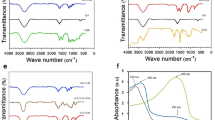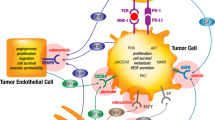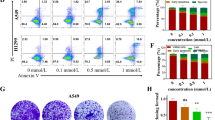Abstract
The doxorubicin (DOX) prodrug N-[4-doxorubicin-N-carbonyl (oxymethyl) phenyl] O-β-glucuronyl carbamate (DOX-GA3) was synthesised for specific activation by human β-glucuronidase, which is released in necrotic areas of tumour lesions. This novel prodrug was completely activated to the parent drug by human β-glucuronidase with Vmax= 25.0 μmol min−1mg−1 and Km= 1100 μM. The pharmacokinetics and distribution of DOX-GA3 in nude mice bearing human ovarian cancer xenografts (OVCAR-3) were determined and compared with DOX. Administration of DOX at 8 mg kg−1 i.v. (maximum tolerated dose, MTD) to OVCAR-3-bearing mice resulted in a peak plasma concentration of the drug of 16.4 μM (t = 1 min). A 7.6-times lower peak plasma concentration of DOX was measured after injection of DOX-GA3 at 250 mg kg−1 i.v. (50% of MTD). In normal tissues the prodrug showed peak DOX concentrations that were up to 5-fold (heart) lower than those found after DOX administration. DOX-GA3 activation by β-glucuronidase in the tumour yielded an almost 5-fold higher DOX peak concentration of 9.57 nmol g−1 (P < 0.05) than the peak concentration of only 2.14 nmol g−1 observed after DOX. As a consequence, the area under the curve of DOX calculated in tumour tissue after DOX-GA3 (13.1 μmol min−1g−1) was 10-fold higher than after DOX (1.31 μmol min−1g−1). The anti-tumour effects of DOX-GA3 and DOX were compared at equitoxic doses in OVCAR-3 xenografts at a mean tumour size of 125 mm3. The prodrug given i.v. at 500 mg kg−1 weekly × 2 resulted in a maximum tumour growth inhibition of 87%, while the standard treatment with DOX at a dose of 8 mg kg−1 i.v. weekly × 2 resulted in a maximum tumour growth inhibition of only 56%. Treatment with DOX-GA3 was also given to mice with larger tumours containing more necrosis. For tumours with a mean size of 400 mm3 the specific growth delay by DOX-GA3 increased from 2.7 to 3.9. Our data indicate that DOX-GA3 is more effective than DOX and suggest that the prodrug will be specifically advantageous for treatment of advanced disease. © 2001 Cancer Research Campaign
Similar content being viewed by others
Article PDF
Change history
16 November 2011
This paper was modified 12 months after initial publication to switch to Creative Commons licence terms, as noted at publication
References
Bosslet K, Czech J and Hoffmann D (1994) Tumor-selective prodrug activation by fusion protein-mediated catalysis. Cancer Res 54: 2151–2159
Bosslet K, Czech J and Hoffmann D (1995) A novel one-step tumor-selective prodrug activation system. Tumor Targeting 1: 45–50
Boven E, Winograd B, Fodstad O, Lobbezoo MW and Pinedo HM (1988) Preclinical phase II studies in human tumor lines: a European multicenter study. Eur J Cancer Clin Oncol 24: 567–573
Boven E, Schluper HM, Erkelens CA and Pinedo HM (1990) Doxorubicin compared with related compounds in a nude mouse model for human ovarian cancer. Eur J Cancer 26: 983–986
Boven E, Hendriks HR, Erkelens CA and Pinedo HM (1992) The anti-tumour effects of the prodrugs N-l-leucyl-doxorubicin and vinblastine-isoleucinate in human ovarian cancer xenografts. Br J Cancer 66: 1044–1047
Connors TA and Whisson ME (1966) Cure of mice bearing advanced plasma cell tumours with aniline mustard: the relationship between glucuronidase activity and tumour sensitivity. Nature 210: 866–867
de Jong J, Guerand WS, Schoofs PR, Bast A and van der Vijgh WJ (1991) Simple and sensitive quantification of anthracyclines in mouse atrial tissue using high-performance liquid chromatography and fluorescence detection. J Chromatogr 570: 209–216
de Jong J, Geijssen GJ, Munniksma CN, Vermorken JB and van der Vijgh WJ (1992) Plasma pharmacokinetics and pharmacodynamics of a new prodrug N-l-leucyldoxorubicin and its metabolites in a phase I clinical trial. J Clin Oncol 10: 1897–1906
Deprez-de Campeneere D, Baurain R and Trouet A (1982) Accumulation and metabolism of new anthracycline derivatives in the heart after IV injection into mice. Cancer Chemother Pharmacol 8: 193–197
Eisenthal R and Cornish-Bowden A (1974) The direct linear plot. A new graphical procedure for estimating enzyme kinetic parameters. Biochem J 139: 715–720
Fishman WH (1970). Metabolic conjugation and metabolic hydrolysis, Academic Press: New York, London
Haisma HJ, Boven E, van Muijen M, de Jong J, van der Vijgh WJ and Pinedo HM (1992) A monoclonal antibody-beta-glucuronidase conjugate as activator of the prodrug epirubicin-glucuronide for specific treatment of cancer. Br J Cancer 66: 474–478
Haisma HJ, Sernee MF, Hooijberg E, Brakenhoff RH, v.dMeulen-Muileman IH, Pinedo HM and Boven E (1998) Construction and characterization of a fusion protein of single-chain anti-CD20 antibody and human beta-glucuronidase for antibody-directed enzyme prodrug therapy. Blood 92: 184–190
Hamilton TC, Young RC, McKoy WM, Grotzinger KR, Green JA, Chu EW, Whang-Peng J, Rogan AM, Green WR and Ozols RF (1983) Characterization of a human ovarian carcinoma cell line (NIH:OVCAR-3) with androgen and estrogen receptors. Cancer Res 43: 5379–5389
Houba PH, Leenders RG, Boven E, Scheeren JW, Pinedo HM and Haisma HJ (1996) Characterization of novel anthracycline prodrugs activated by human beta-glucuronidase for use in antibody-directed enzyme prodrug therapy. Biochem Pharmacol 52: 455–463
Houba PHJ, Boven E, Leenders RGG, Pinedo HM and Haisma HJ (1998) The efficacy of the anthracycline prodrug daunorubicin-GA3 in human ovarian cancer xenografts. Br J Cancer 78: 1600–1606
Houba PH, Boven E, van der Meulen-Muileman IH, Leenders RG, Scheeren JW, Pinedo HM and Haisma HJ (1999) Distribution and pharmacokinetics of the prodrug daunorubicin-GA3 in nude mice bearing human ovarian cancer xenografts. Biochem Pharmacol 57: 673–680
Kearney AS (1996) Prodrugs and targeted drug delivery. Adv Drug Deliv Rev 19: 225–239
Leenders RGG, Gerrits KAA, Ruijtenbeek R, Scheeren HW, Haisma HJ and Boven E (1995) β-Glucuronyl carbamate based pro-moieties designed for prodrugs in ADEPT. Tetrahedron Lett 36: 1701–1704
Leenders RG, Damen EW, Bijsterveld EJ, Scheeren HW, Houba PH, van der Meulen-Muileman IH, Boven E and Haisma HJ (1999) Novel anthracycline-spacer-beta-glucuronide, -beta-glucoside, and -beta-galactoside prodrugs for application in selective chemotherapy. Bioorg Med Chem 7: 1597–1610
Levvy GA and Conchie J (1966) β-glucuronidase and the hydrolysis of glucuronides. Glucuronic acid, free and combined, Dutton GJ (ed), pp 301–364, Academic Press: New York
Martin GR and Jain RK (1994) Noninvasive measurement of interstitial pH profiles in normal and neoplastic tissue using fluorescence ratio imaging microscopy. Cancer Res 54: 5670–5674
Molthoff CF, Calame JJ, Pinedo HM and Boven E (1991) Human ovarian cancer xenografts in nude mice: characterization and analysis of antigen expression. Int J Cancer 47: 72–79
Schumacher U, Adam E, Zangemeister-Wittke U and Gossrau R (1996) Histochemistry of therapeutically relevant enzymes in human tumours transplanted into severe combined immunodeficient (SCID) mice: nitric oxide synthase-associated diaphorase, beta- D -glucuronidase and non-specific alkaline phosphatase. Acta Histochem 98: 381–387
Sinhababu AK and Thakker DR (1996) Prodrugs of anticancer agents. Adv Drug Deliv Rev 19: 241–273
Tomino S and Paigen K (1975) Purification and chemical properities of mouse liver lysosomal (L form) beta-glucuronidase. J Biol Chem 250: 8503–8509
Weiss RB (1992) The anthracyclines: will we ever find a better doxorubicin?. Semin Oncol 19: 670–686
Young CW, Yagoda A, Bittar ES, Smith SW, Grabstald H and Whitmore W (1976) Therapeutic trial of aniline mustard in patients with advanced cancer. Cancer 38: 1887–1895
Yuan F, Baxter LT and Jain RK (1991) Pharmacokinetic analysis of two-step approaches using bifunctional and enzyme-conjugated antibodies. Cancer Res 51: 3119–3130
Author information
Authors and Affiliations
Corresponding author
Rights and permissions
From twelve months after its original publication, this work is licensed under the Creative Commons Attribution-NonCommercial-Share Alike 3.0 Unported License. To view a copy of this license, visit http://creativecommons.org/licenses/by-nc-sa/3.0/
About this article
Cite this article
Houba, P., Boven, E., Meulen-Muileman, I. et al. A novel doxorubicin-glucuronide prodrug DOX-GA3 for tumour-selective chemotherapy: distribution and efficacy in experimental human ovarian cancer. Br J Cancer 84, 550–557 (2001). https://doi.org/10.1054/bjoc.2000.1640
Received:
Revised:
Accepted:
Published:
Issue date:
DOI: https://doi.org/10.1054/bjoc.2000.1640
Keywords
This article is cited by
-
Evaluation of Cytotoxic Properties of a Cyclopamine Glucuronide Prodrug in Rat Glioblastoma Cells and Tumors
Journal of Molecular Neuroscience (2015)
-
Monitoring subcellular biotransformation of N-l-leucyldoxorubicin by micellar electrokinetic capillary chromatography coupled to laser-induced fluorescence detection
Analytical and Bioanalytical Chemistry (2014)
-
Expression of β-glucuronidase on the surface of bacteria enhances activation of glucuronide prodrugs
Cancer Gene Therapy (2013)
-
Enhancement of CPT-11 antitumor activity by adenovirus-mediated expression of β–glucuronidase in tumors
Cancer Gene Therapy (2011)
-
Membrane-localized activation of glucuronide prodrugs by β-glucuronidase enzymes
Cancer Gene Therapy (2007)



